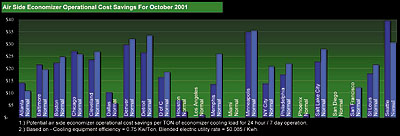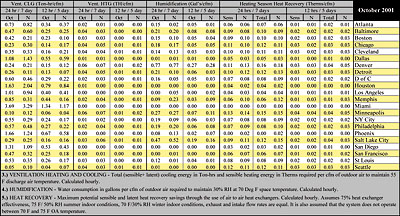
The economizer hours in this report represent the number of hours that economizer systems can provide 100% of any required off-season cooling. This data can be used to estimate the potential cost savings to justify the installation of a new economizer system or evaluate the performance of an existing system given a known economizer cooling load. The economizer cooling load is comprised mostly of heat gain from internal sources such as people, lights, equipment, and processes. Figure 2 illustrates the cost savings per ton of economizer cooling load for October using the economizer hours in the report.

Two Types of Systems
There are basically two types of economizer systems, airside economizers and waterside economizers. Airside economizer systems mix outdoor air directly with the return air to maintain a constant supply air temperature to the space (commonly 55 degrees F). The normal method of mechanical cooling (DX or chilled water system) would be off, resulting in significant energy savings. The airside economizer hours in the report are the total number of hours when the outside air dry bulb temperature is less than 55 degrees.
Waterside economizer systems typically pump cold condenser water from a cooling tower through a heat exchanger to generate chilled water in lieu of operating chillers. Some systems are designed without a heat exchanger, pumping the tower water directly to the cooling coils. The maximum outdoor wet bulb temperature that would allow for waterside economizer cooling is approximately 40 degrees. Above this wet bulb temperature, it's usually not possible to generate chilled water below 47 degrees given the limited approach to the cooling tower and thermal efficiency heat exchanger losses. The waterside economizer hours in the report are the total number of hours when the outside air wet bulb temperature is less than 40 degrees.

Crunching The October Data
The reported October economizer hours indicate that the airside economizer hours were below normal for much of the country, resulting in less savings and potentially higher mechanical cooling costs. For example, if an office building in Detroit has 600,000 sq ft of internal office space with 5 W/sq ft of sensible heat gain from people, lights, and equipment, the economizer cooling load would be 600,000 x 5 x 3.413¿12,000 = 853 tons. The airside economizer savings for the building when fully occupied during business hours would be:October 2001 airside economizer savings = 853 x 108 x 0.75 x 0.12 = $8,281
Normal airside economizer savings for October = 853 x 126 x 0.75 x 0.12 = $9,662
The calculation assumes 0.75 kW/ton cooling efficiency and $0.12 /Kwh electric utility rate. Obviously there are other factors that could come into play and change these results, like variable occupancy schedules, equipment efficiencies, and electric rates. But the objective is to use the data to determine order of magnitude cost savings and evaluate the influence that the weather has on economizer cooling systems. This can be accomplished by keeping all other factors constant.
The reported waterside hours indicate that it probably was not worthwhile to initiate water side economizer cooling systems during the month of October for most of the country with the possible exceptions of Denver, Minneapolis, and Salt Lake City. Typically, these systems are not utilized until the wet bulb temperature is consistently below 40 degrees. If the hours are sporadic, the mechanical cooling equipment would require frequent restarts, which is typically not recommended. ES
